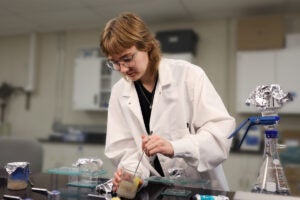AUSTIN, Texas —In 1824, English chemist Sir Humphrey Davy discovered a process called cathodic protection, preserving the new steel-hulled ships of the British navy against oxidation, commonly known as rusting or corrosion. Today, cathodic protection is employed on ships, pipelines, offshore oilrigs and numerous other metal structures.
A hypothesis formulated by Dr. Adam Heller, who holds the Ernest Cockrell Sr. Chair in Engineering at The University of Texas at Austin, suggests that genes also may be cathodically protected against oxidation. Oxidation refers to the chemical change that begins with the transfer of electrons to oxygen or another oxidizer. In genes, oxidation leads to deterioration that can result in cell mutation, aging and disease.
“The subject is important because it adds to the information we have on processes of aging, mutations, cancer and the therapy of cancer,” said Heller. Heller presented the hypothesis of cathodic protection of genes when he was awarded the prestigious Spiers Medal by Great Britain’s Royal Society of Chemistry for an outstanding contribution to chemical physics or physical chemistry.
Heller explained that when a piece of zinc and a piece of steel are joined, their electrons travel freely between the two metals. The zinc corrodes and the corrosion of the steel is stopped. “This is known as cathodic protection,” said Heller.
When two conducting materials are in contact with each other, cathodic protection prevents one conductor, the cathode, from rusting or rotting through reaction with oxygen. At the same time, the anode — the conductor that loses electrons most easily — corrodes. According to Heller’s hypothesis, the same process also protects genes, which behave as cathodes, while other parts of DNA behave as anodes.
Each cell contains lengthy strands of DNA (deoxyribonucleic acid) comprising the genome, which holds the code for all genetic information. In animals, the genome is composed of chromosomes. Genes are parts of the chromosome that encode individual protein molecules. Between the genes are lengths of material whose function scientists do not yet understand, once referred to as junk DNA. Heller’s hypothesis proposes that part of the junk DNA plays the same sacrificial role as zinc does, giving up electrons while protecting the genes themselves.
The basic units of DNA are chemical structures containing guanine (G), adenine (A), thymine (T) and cytosine (C). Adenine pairs with thymine and guanine pairs with cytosine forming base pairs. Heller said it appears likely that, within junk DNA, thousand-base-pair-long stretches of G-C pairs constitute sacrificial anodes. If true, then the presence of extended G-rich regions is a critical factor affecting key characteristics of cells, including their aging, death and the likelihood of their mutation.
“As the genes lose their cathodic protection and, as a result, become more oxidation prone, the cells age,” he said. “They undergo changes that, in the good case, result in their death. In the bad case, the oxidation results in cancer-causing mutation.”
Heller’s hypothesis is based on previous experimental work of research groups in the United States, Europe, Japan and Israel, including his own research group. “What I’m doing in this particular case is putting together a puzzle, and the pieces of the puzzle are mostly not my work. They represent the work of many, many different groups all over the world,” said Heller.
For example, the surprising discovery that thousand-base-pair long strands of DNA are electronic conductors was made by Swiss researchers in 1999. DNA actually conducts electron vacancies that are referred to as holes. An electron vacancy represents a missing electron from bond between atoms. A hole moves in a direction opposite to that of an electron in an electric field and is therefore assigned a positive charge, Heller explained.
Heller said that two recent studies, one in Japan in 1998 and his own in 1999, suggest an intriguing difference in the way these electron vacancies, or holes, are conducted across the base pairs forming the DNA molecules, which are rod-like. The rods, made of more than a thousand base pairs, appear to conduct electron vacancies only when lined up in a parallel pattern, like trees in a forest, Heller explained. When they are not aligned in a parallel fashion, the conduction of holes takes place across far shorter distances — only across dozens of base pairs. This is too small a distance to protect genes (which are several thousand base-pairs long) from mutating through oxidation.
Heller said that a series of experiments must be performed to test the validity of the hypothesis and its potentially revolutionary medical implications. Dr. Heller’s research has been funded by the Welch Foundation and the National Science Foundation.
Heller announced his hypothesis during the 116th Faraday Discussion held at the University of Southampton, England, in July. The Faraday Discussions were named in honor of Sir Michael Faraday, one of the giants of physics and chemistry, who started out as an assistant of Sir Humphrey Davy. The text of Heller’s Spiers Memorial Lecture will be published in the next several weeks.
For more information, contact Dr. Adam Heller at (512) 471-8874 or Becky Rische at the UT Austin College of Engineering at (512) 471-7272. Heller’s Website is www.che.utexas.edu/graduate_research/heller.html The Faraday Discussions Website is www.rsc.org/faraday_d



